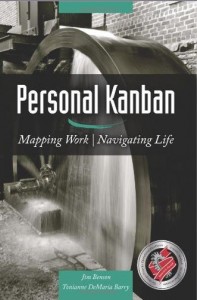Several weeks ago, after a sleepless night as the deadline for a big project loomed, I realized that Agile planning could help me gain control of my own workflow—even though Agile is usually promoted as a way to better collaborate with others. I had delved into Agile last fall to write a case study for a client, and I was curious to learn more about the topic, so the client directed me to a book entitled Personal Kanban.
Recently I wrote about the benefits of deadlines, which are one of the basic tenets of the Agile approach to time management. Here are a few others:
- Before starting any project, predict how much time it will take (and then track the actual hours, to improve future estimates).
- Have a strict “definition of done,” and stick to it.
- After a project (or designated work period) is complete, review what could be improved.
- Don’t try to multitask; finish one project before starting another.
- Don’t do more; do better.
Personal Kanban
Personal Kanban: The Book is a quick read (I consumed it on a four hour airplane ride), and I highly recommend it for anyone who is ready to increase their own efficiency at work, at home, or even with hobbies. We all tend to begin any project with unreal expectations about how fast we will actually complete it and what will be included; whenever I first sit down to write a book (or even a blog post), I always think it will take just a few hours and include every great idea I’ve ever come up with. Based on previous experience, I know that writing a novel will take me a few years, while a short blog post takes a few hours. (And both will be better if they are limited in scope to only a few of my best ideas.)
So the first step is to limit our Work In Progress (WIP) to two or three projects at a time. But obviously, “write a blog post” doesn’t equal “write a novel,” though both could be written on a sticky-note and called “projects.” So one important aspect of all this is to understand the scope of what we’re trying to accomplish. Only then can we estimate what can realistically be completed in a pre-determined time frame (a day, a weekend, a month), which forces us to divide up anything larger into tasks that will fit into each specified time frame.
The goal is not endless planning (boring) but continuous improvement (exciting), which is why comparing our initial guesses about how long a job will take to the actual hours we put in is so important. Writing a novel will take more than a weekend afternoon, while writing a blog post should take less; understanding that is my the first step toward completing either job. It’s also a valuable way to gain control of all the conflicting demands on my time.
The standard workday used to be walled off from personal hours in both space and time; once you left the office at the end of the day, work was over until you returned there the next morning. These days, work bleeds over into personal time, thanks to our constant availability. So we have to find new ways to time-box the demands on our days.
Once I’d planned out my workflow for the last week before the big project deadline, I slept well again. I knew how long each project would take, which forced me to give up on a few more edits I would’ve preferred to make. Even those of us who work by ourselves can benefit from the Agile approach; it can help anyone who’s frustrated by (or worse still, can’t remember) how much she accomplished yesterday.
2 Replies to “The Positives of Personal Planning”
Comments are closed.